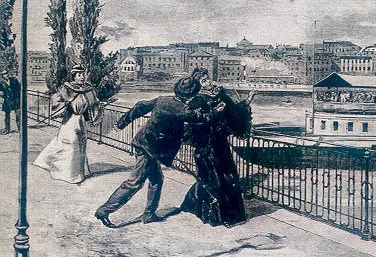She was “so beautiful, in mind and heart, in person and spirit; and whether with a crown upon her head or without it and nameless, a grace to the human race”. That was the author Mark Twain writing about the Empress Elisabeth of Austria, who died 125 years ago this September, murdered by an unhinged anarchist on the shores of Lake Geneva.
In this anniversary year, the Empress, also known as Sisi, is back in fashion. An arty, gruelling film about her life, Corsage, has won awards. The Netflix series The Empress—a continental counterpart to The Crown—is getting a second series. It presents her as a free spirit, dubiously modern, a kind of cross between Princess Diana and the Duchess of Sussex.
The Diana parallels are rather striking, though. Sisi’s death shocked the world, much as Diana’s death would a century later. Like Diana’s, Sisi’s life now seems as much myth as history, a dark fairytale of a girl who learned that the dream of being a princess was in fact a nightmare of constriction and contradictory demands, which would ultimately lead to her death.
Like Lady Diana Spencer, the Duchess Elisabeth Amalie Eugenie of Bavaria was born into a noble family, but without expectation of a crown. As with Diana, at first it looked as if the royal blessing might be bestowed upon her older sister. In his 20s, Prince Charles briefly dated the older Spencer girl, Sarah, before turning his attentions to her willowy younger sibling. In 1853, it was the older Helene of Bavaria being lined up for Franz Joseph of Austria. Yet as soon as he saw the 15-year-old Sisi, the Emperor knew which sister he wanted.
“Celebrity,” John Updike remarked, “is a mask that eats into the face”. The metaphor overlooks the fact that, especially for women, the body, as much as the face, is what is corroded. From her wedding day, much of which she spent in tears, Sisi was obsessed with maintaining her enormous hair and tiny waist, which between them had caught the imperial eye.
The daily preparation of her hair was said to take three hours. Afterwards, Sisi was crowbarred into her corset, which took another hour. Although she was tall, at 5ft 8in, she had a waist you could almost get two hands around, measuring as little as 16in. Before going fox-hunting, she was sometimes literally sewn into her clothes to accentuate her figure.
Her beauty regime was savage. Sisi slept on an iron bed-frame with no pillow. For her face, she wore a silk mask packed with raw veal, or one laced with crushed strawberries and vaseline. And of course, she hardly ate a thing. Her diet consisted largely of milk and eggs, and a thin soup made from the juice of beefsteaks. She weighed herself three times a day.
The Empress was not only anorexic, but also, like Princess Diana, bulimic. Anorexia means you starve yourself. Bulimia—the word comes from the Greek for the hunger of an ox—means that you binge-eat, and then purge. Sisi purged by exercise. Wherever she went, she took a mobile gym of dumbbells and gymnastic rings, from which she hung upside down like a bat.
While renting out Combermere Abbey in Shropshire for two years in the 1880s, she rode out to hounds six days a week. I am told by the Abbey’s owner, Sarah Callander Beckett, that Sisi arrived with 17 horses from Austria. The train carrying her servants and kit had so many carriages that the nearby station of Wrenbury had to have its platforms extended.
The grim diet, the grinding beauty routine, the endless exercising—all were expressions of the misery that was her constant companion. And little wonder, when you think about it.
From the moment she became Empress, Sisi was told that her function was to produce children. When she did, her mother-in-law, Princess Sophie, took them from her. Sisi threw herself into maintaining her figure to please her husband. He repaid her by having affairs and giving her syphilis. She retaliated by staying away from court. Her mortified husband didn’t dare complain. She travelled relentlessly—from Hungary to Greece to Turkey to Egypt to Morocco—as if she might stumble by continual motion on the happiness that eluded her.
Her absence from Vienna had another advantage: no one would see her grow old. Sisi refused to let anyone take a picture of her after the age of 30. Wherever she went, she carried a fan. When she spotted a photographer, she flicked it open to hide her face. This was her version of the angry palm pushed into the lens, which we later saw from Princess Diana.
As with certain other members of royal families, one is torn between feeling sorry for Sisi and wondering if she was especially interesting or nice. Some of her prejudices sound all too commonplace. She despised anyone overweight, for instance, sneering at the Empress of Mexico and her own daughter-in-law for this failing. She passed the bias on to her children.
In her defence, Sisi was plagued by bereavement. She lost a daughter in infancy. Her beloved cousin Ludwig drowned in 1886. Her only son Rudolph killed himself in 1889. Nevertheless, as with many royals, the deeper tragedy of her life was located in a paradox inherent to monarchy: the gulf between her ordinariness and the extraordinary things required of her.
At Princess Diana’s funeral, Earl Spencer compared his sister with another Diana, the goddess of hunting. In Corfu, after the death of her son, the devastated Sisi tried to create a classical myth of her own. On a headland, she ordered a palace to be built dedicated to the Greek warrior Achilles. She called it the Achilleion and hoped she would be happy there.
The palace, which you can visit to this day, is more of a curiosity than a wonder. There’s little sign that Sisi had much in the way of taste—with one exception. In pride of place on a terrace, there’s a terrific neoclassical statue of the Dying Achilles by Ernst Herter. The soldier, naked save for his helmet, twists in agony as he tries to pluck from his heel the arrow that will kill him. The irony of his death was that this was fired by Helen’s lover, Paris, the scurrilous pick-up artist, who dispatched with a cowardly dart the greatest fighter of all time.
Mark Twain drew a similar contrast in 1898 between the greatness, as he saw it, of Empress Sisi, and the paltry nature of the man who killed her, using a kind of improvised arrow.
On 10 September 1898, in Geneva, Sisi stepped out without a bodyguard. The Italian anarchist Luigi Lucheni approached her on the strand. He was armed with a four-inch file he had sharpened into a needle, which he plunged it into her heart. Sisi didn’t die straightaway. Her corset restricted the bleeding. The killer was caught and sentenced to life imprisonment.
Twain let himself off the verbal leash, calling Lucheni “a soiled and patched young loafer, without gifts, without talents, without education, without morals, without character”.
Yet as happened with Diana a century later, when Sisi died, all her sins were forgiven. “Crowns have adorned others,” Twain concluded, “but she adorned her crowns.”

